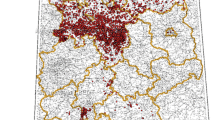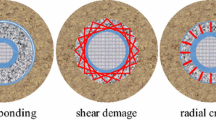Abstract
The implementation of an underground CO2 storage requires evidence that the storage is and will remain tight in the future. This refers to the cap rock and the wells penetrating it. Assessment and verification of well integrity of accessible wells is technically possible. The available methods, allowing a direct assessment, were evaluated and a measurement and testing strategy is proposed. Unlike accessible wells, already plugged ones require predictive methods for their assessment. These are based on well information and a comprehensive understanding of the coupled thermal, hydraulic, mechanical and chemical processes during well construction, operation and after abandonment. The methods have been applied to a well zone characterised by conditions typical for the subsurface in the area of interest and with regard to the potential injection site in the Altmark. The calculated safety margins emphasize that technical well integrity of the 12 examined boreholes is given for enhanced gas recovery injecting 100,000 t of CO2 in the Altensalzwedel subfield without a need for any further intervention.
Self-healing of defects was investigated in full-scale experiments under in-situ conditions. In addition to the expected self-healing as a result of salt creep, healing was also observed resulting from the interaction of salt, cement and casing with dry or wet CO2.
Methods and technologies for CO2 well monitoring and intervention presented here are sufficient for the mining safety of CO2 storage wells under high pressure. The system contains technologies proven under field conditions as well as procedures in which CO2 was applied.
An innovative well abandonment concept was developed and tested in the field for the long-term containment of CO2 in depleted Rotliegend gas reservoirs. It aims at amending the conventional standard well abandonment procedure, takes advantage of the natural creeping ability of the thick, homogeneous Zechstein salt formation located at around 3,000 m depth in the Altmark area and consists of four main sealing units: (1) a standard sealing element with cement from the reservoir to the impermeable cap rock, (2) a salt plug created in the formerly reamed section of casing within the plastic Zechstein (Upper Permian) rock salt formation, (3) two bridge plugs at the bottom and top of the salt plug and (4) standard cement sealing elements from the top bridge plug to the ground surface. Comprehensive numerical simulations conducted prior to and during the field test in 2010 and 2011 successfully predicted the evolution of the now proven convergence using downhole measurement data. This new long-term sealing concept has been successfully tested at the Altmark natural gas field.
Access this chapter
Tax calculation will be finalised at checkout
Purchases are for personal use only
Similar content being viewed by others
References
Abdel-Haq A (2006) Erfahrung bei der Durchführung des Dichtheitstestes an den letzten zementierten Rohrtouren der Kavernenfelder EPE und Bad Lauchstädt. 57. Berg- und Hüttenmännischer Tag, 22–23 Juni 2006
Bachu S, Bennion DB (2009) Experimental assessment of brine and/or CO2 leakage through well cements at reservoir conditions. Int J Greenhouse Gas Control 3:494–501
Barlet-Gouédard V, Rimmelé G, Porcherie O, Quisel N, Desroches J (2009) A solution against well cement degradation under CO2 geological storage environment. Int J Greenhouse Gas Control 3:206–216
Berest P, Brouard B, Durup G (2002) Tightness tests in salt-cavern wells. Technical paper. Solution Mining Research Institute, Spring 2002 Meeting, 28 April–1 May 2002, Banff. http://brouard-consulting.com/articles/tightness-banff_OnlinePDF.pdf
Bradshaw RL, Boegly WJ, Empson FM (1964) Correlation of convergence measurements in salt mines with laboratory creep-test data. In: The 6th U.S. symposium on rock mechanics (USRMS), 28–30 Oct 1964, The University of Missouri Rolla, Rolla, pp 501–514
Bruckdorfer RA (1986) Carbon dioxide corrosion in oilwell cements. Society of Petroleum Engineers SPE 15176
Carey JW, Wigand M, Chipera SJ, Wolde-Gabriel G, Pawar R, Lichtner PC, Wehner SC, Raines MA, Guthrie GD Jr (2007) Analysis and performance of oil well cement with 30 years of CO2 exposure from the SACROC Unit, West Texas, USA. Intl J Greenhouse Gas Control 1(1):75–85
Condor J, Asghari K (2009) An alternative theoretical methodology for monitoring the risks of CO2 leakage from wellbores. Energy Procedia 1:2599–2605
Crow W, Carey JW, Gasda S, Williams DB, Celia M (2010) Wellbore integrity analysis of a natural gas producer. Int J Greenhouse Gas Control 4:186–197
Fjaer E, Holt RM, Horsrud P, Raaen AM, Risnes R (2008) Petroleum related rock mechanics. Dev Petr Sci 53:299–304
Fuenkajorn K, Daemen JJK (1996) Sealing of boreholes und underground excavations in rock. Chapman & Hall, London, pp 184–211
Hendricks (2009) Experiences in the Salt Creek Field CO2 flood. In: 5th annual wellbore integrity network, Calgary, 13–14 May 2009
Heusermann S, Lux KH, Rokahr R (1983) Entwicklung mathematisch-mechanischer Modelle zur Beschreibung des Stoffverhaltens von Salzgestein in Abhängigkeit von der Zeit und der Temperatur auf der Grundlage von Laborversuchen mit begleitenden kontinuumsmechanischen Berechnungen nach der Methode der finiten Elemente. BMBF-Forschungsbericht T 83–218. Lehrgebiet Unterirdisches Bauen der Universität Hannover
Hou Z (1997) Untersuchungen zum Nachweis der Standsicherheit für Untertagedeponien im Salzgebirge. Dissertation an der TU Clausthal, Papierflieger Verlag in Clausthal-Zellerfeld
Hou Z (2002) Geomechanische Planungskonzepte für untertägige Tragwerke mit besonderer Berücksichtigung von Gefügeschädigung, Verheilung und hydromechanischer Kopplung. Habilitationsschrift an der TU Clausthal, Papierflieger Verlag in Clausthal-Zellerfeld
Hou Z (2003) Mechanical and hydraulic behaviour of salt in the excavation disturbed zone around underground facilities. Int J Rock Mech Min Sci 40(5):725–738
Hou Z, Wundram L (2009) Langzeitverschluss der CO2-Entsorgung in einer Erdgaslagerstätte zur Erhöhung der Ausbeutungsrate: Vergleich mit der Endlagerung radioaktiver Abfälle in einem alten Bergwerk. Energie und Rohstoffe, Goslar, 9–12 Sept 2009, pp 317–334
Hou Z, Wang Q, Xie L, Liu J, Zhang R (2010) The Hou’s short- and long-term strength model, the Hou/Lux constitutive model for rock salt as well as their applications in storage cavern design. In: Hou Z, Xie H, Yoon JS (eds) Underground storage of CO2 and energy. CRC Press/Balkema, Leiden, pp 95–103
ITE (2007) Feasibility study on the potential of CO2 storage for enhancing recovery in mature German gas reservoirs (CSEGR) – work package 2: CO2 injection/production and well integrity. Beitrag zum Abschlussbericht des Gemeinschaftsvorhabens unter dem BMBF Sonderprogramm GEOTECHNOLOGIEN
Jacobsen S, Marchand J, Gerard B (1998) Concrete cracks І: durability and self healing. In: Gjorv OE, Sakai K, Banthia NE (eds) Proceedings of the second international conference on concrete under severe conditions. E & FN Spon, Tromso, pp 217–231
Krilov Z, Loncaric B, Miksa Z (2000) Investigation of a long-term cement deterioration under a high temperature sour gas downhole environment, Society of Petroleum Engineers. The 2000 SPE international symposium on formation damage control, Lafayette, 23–24 Feb 2000, Paper no. SPE 58771, pp 547–555
Mazurek M, Pearson FJ, Volckaert G, Bock H (2003) Features, events and processes evaluation catalogue for argillaceous media. Radioactive Waste Management, ISBN 92-64-02148-5. © OECD 2003
Nygaard R (2010) Well design and well integrity, Wabamun area CO2 sequestration project (WASP), Energy and Environmental Systems Group, Institute Sustainable Energy, Environment and Economy (ISEEE), University of Calgary, p 39
Quintessa (2011) CO2 FEP data base. http://www.quintessa-online.com/co2/
Reinicke KM, Fichter C (2009) CO2 Lagerung im Geogrund: Bohrungsintegrität akzeptabel für CSEGR (carbon sequestration with enhanced gas recovery) Part 1 and 2. Erdöl-Erdgas-Kohle, Januar und Februar 2009
Reinicke KM, Fichter C (2010a) Measurement strategies to evaluate the integrity of deep wells for CO2 applications. Proceedings of the Sino-German conference on underground storage of CO2 and energy, Beijing, 6–13 July 2010
Reinicke KM, Fichter C (2010b) Entwicklung von Prüfstrategien zur Bewertung der technischen Integrität von Bohrungen. DGMK/ÖGEW-Frühjahrstagung 2010, Fachbereich Aufsuchung und Gewinnung, Celle, 12–13 Apr 2010
Reinicke KM, Weichmann MJ (2011) Risikobewertung verfüllter Bohrungen unter dem Einfluss von CO2. Freiberger Forschungsforum 2011, 8. Fachkolloquium GEO Förderung und Speicherung von Energie im Untergrund, 15–17 Juni 2011
Reinicke KM, Franz O, Fichter C (2009a) Bohrungsintegrität akzeptabel für CSEGR CO2-Lagerung im Geountergrund (1). Erdöl Erdgas Kohle 125(1):27–31
Reinicke KM, Franz O, Fichter C (2009b) Bohrungsintegrität akzeptabel für CSEGR CO2-Lagerung im Geountergrund (2). Erdöl Erdgas Kohle 125(2):66–67
Reinicke KM, Bai M, Fichter C, Weichmann MJ, Weinlich FH (2011a) Leckagerisiko von Bohrungen unter Einfluss von CO2: Von den FEPs bis zu den Szenarien. DGMK/ÖGEW-Frühjahrstagung 2011, Celle, 11–12 Apr 2011
Reinicke KM, Teodoriu C, Fichter C, Weichmann MJ, Weinlich FH, Krebs R, Zhang Z-L (2011b) Untersuchung von Selbstheilungsmechanismen im Verbundsystem Rohr-Zement-Gebirge von CO2-Bohrungen. DGMK/ÖGEW-Frühjahrstagung 2011, Celle, 11–12 Apr 2011
Schlangen E, Rooij M de (2005) Self-healing phenomena in cement-based materials. International union of laboratories & experts in construction materials, systems and structures, technical committee 221-SHC. http://www.rilem.net/gene/main.php?base=8750%26gp_id=228
Schmitt G, Zhang Y, Gao K (2011a) Water effect on steel corrosion under supercritical CO2 conditions, NACE CORROSION’2011, Houston, 13–17 Mar 2011, Paper 11378
Schmitt G, Zhang Y, Gao K (2011b) Water effect on steel corrosion under supercritical CO2 conditions. Mater Perform 50(6):62
Schmitt G, Zhang Y, Gao K (2011c) Inhibition of steel corrosion under aqueous supercritical CO2 conditions, NACE CORROSION’2011, Houston, 13–17 Mar 2011, Paper 11379
Schmitt G, Zhang Y, Gao K (2011d) Inhibition of steel corrosion under aqueous supercritical CO2 conditions. Mater Perform 50(9):54
Schmitt G, Zhang Y, Gao K (2011e) Corrosion inhibition of steels in aqueous media in contact with supercritical carbon dioxide, EUROCORR’2011, 4–8 Sept. 2011, Stockholm, Paper 4717
Schmitt G, Zhang Y, Gao K (2011f) Effect of oxygen on steel corrosion under supercritical CO2 conditions, EUROCORR’2011, 4–8 Sept. 2011, Stockholm, Paper 1103
Schmitt G, Zhang Y, Gao K (2011g) Corrosion inhibition of CRAs in systems with supercritical carbon dioxide, 18th international corrosion congress, 20–24 Nov 2011, Perth, Paper 82
Schmitt G (2011h) Stähle in überkritischen CO2 Systemen – Unerwarteter Sauerstoff-Effekt, GfKORR-Workshop: CCS-Technologie – Werkstofffragen prozesstechnisch lösen, 14 Dec 2011, DECHEMA, Frankfurt/Main
Schmitt G, Zhang Y, Gao K, Hausler RH (2012) Modeling steel corrosion under supercritical CO2 conditions. Mater Corrosion 63(2). doi:10.1002/maco.201106382, in press
Siemann MG (2007) Herkunft und Migration mineralgebundener Gase der Zechstein 2 Schichten in Zielitz. Kali Steinsalz 3:26–41
Sjaardema GD, Krieg RD (1987) A constitutive model for the consolidation of crushed salt and its use in analyses of backfilled shaft and drift configurations. SAND87-1977. Sandia National Laboratories, Albuquerque
SMRI (1996) SMRI reference for external well mechanical integrity testing/performance, data evaluation and assessment; SMRI Spring meeting, Crotogino F., Short Class, Houston
Teodoriu C, Reinicke KM, Fichter C, Wehling P (2010) Investigations on casing-cement interaction with application to gas and CO2 storage wells. SPE 131336, 2010 EAGE/SPE EUROPEC, 14–17 June 2010, Barcelona
Tran Viet T (2010) Bewertung Technische Integrität: Bewertung bestehender Verfahren, In: CLEAN Zwischenbericht Dezember 2009 und CLEAN Jahrestreffen Januar 2010
Williams S, Carlsen T, Constable K, Guldahl G (2009) Identification and qualification of shale annular barriers using wireline logs during plug and abandonment operations. SPE/IADC 119321, SPE Well Abandonment, Aberdeen, 30 June 2009. http://www.spe-uk.org/Downloads/Well-Abandonment-09/1530_Shale_Annular_Barriers_E_Gudding_StatoilHydro_OnlinePDF.pdf
Zhang C-L, Müller J, Ziesche U (2011) Untersuchungen zur Integrität von Rohr-Zement-Salz. Teilprojekt des Verbundvorhabens EGR Altmark CO2SAFE. Unveröffentlichter GRS-Laborbericht im Auftrage des ITE (TUC)
Author information
Authors and Affiliations
Corresponding author
Editor information
Editors and Affiliations
Rights and permissions
Copyright information
© 2013 Springer-Verlag Berlin Heidelberg
About this chapter
Cite this chapter
Reinicke, K.M. et al. (2013). Well Integrity. In: Kühn, M., Münch, U. (eds) CLEAN. Advanced Technologies in Earth Sciences. Springer, Berlin, Heidelberg. https://doi.org/10.1007/978-3-642-31677-7_3
Download citation
DOI: https://doi.org/10.1007/978-3-642-31677-7_3
Published:
Publisher Name: Springer, Berlin, Heidelberg
Print ISBN: 978-3-642-31676-0
Online ISBN: 978-3-642-31677-7
eBook Packages: Earth and Environmental ScienceEarth and Environmental Science (R0)




